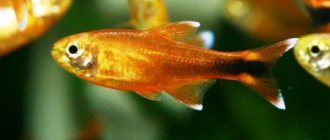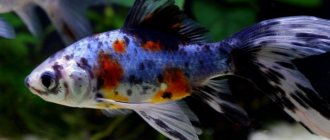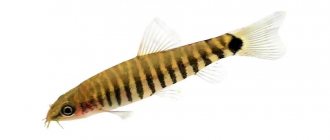Home › Aquarium fish ›
Your rating will be the first!
The lionhead is one of the most popular and well-known goldfish today with a characteristic feature - a missing dorsal fin. The absence of a dorsal fin is also found in Bubble Eye and Celestial Eye goldfish. Also, unlike the goldfish and shubunkin, which have a long slender body, the lionhead is more rounded or ovoid in shape.
The lion head was bred in China and is distinguished by its “cap”, depicting the mystical image of a lion dog. The appearance of this "lion's mane" has led to the common name for goldfish bearing this trait as "lionheads." The size of the growth on the head differs for each individual fish. In some fish, the entire head, except for the eyes, mouth and nostrils, may be covered with a fleshy growth, which can lead to impaired vision. Some flax-headed goldfish may be without any growth on the head. The lionhead has a double caudal fin and a double anal fin.
Origin
All varieties of goldfish are descendants of a single wild carp known as the silver carp or Prussian silver carp, described in 1782.
Goldfish were originally developed in China, then sold to Japan, later appeared in Europe, and after another 100 years, in the 19th century, they ended up in America. Most goldfish species were developed by Asian breeders. Today, pet goldfish are distributed throughout the world, with more than 125 varieties bred in captivity.
The lionhead goldfish or Chinese flaxhead is one of the oldest varieties of goldfish. In China, the fish was bred with a growth on its head, depicting the mythical image of the Chinese lion dog. Its ancestor was an egg-shaped fish known as Maruko in Japan. Lionheads and other goldfish that lack a dorsal fin are descended from this egg-shaped fish. The egg-shaped fish themselves are now found in Asian countries, but are not popular in other countries, are rare and are expensive.
Appearance in the West
When Luo Han specimens were first imported into the United States, only two breeds of this hybrid were common, namely the regular Flower Horn and the Gold Horn. Flower Horns are presented in two variations: with a pearl tint (silver-white dots on the scales) and without them. Individuals with a Golden background are also presented in two variations: faded and not. Flower Horns with a pearly tint quickly overtook their non-tinted relatives in popularity, and were soon given the name “pearlscale” or Zhen Zhu. As for the variation with a Golden background, individuals with a shimmer were popular, which acquired an attractive golden hue instead of the gray color of the Flower Horns.
By 1999, there were four lines of Flower Horns on the American market: regular, pearl-scaled, golden-colored, and faded. The number of commercial breeders grew rapidly. Fish were chosen based on their appearance and neglecting terminology. As a result, the names of the fish no longer meant anything, and it became difficult to track the pedigree.
The Kamfa breed appeared in 2000–2001. This is the name given to hybrids resulting from crossing any Flower Horn with a representative of the genus Vieja or a red parrot. Thanks to this, the fish acquired such features as a short muzzle, elongated fins, sunken eyes and very prominent frontal tubercles. Having noticed this, they began active linear breeding of their fish, trying to ensure that the individuals became brighter and could compete with the species of Kafma.
Description
The lionhead goldfish has a short, stocky body, a double caudal fin and a double anal fin. Lionheads, as a rule, reach 13 cm in length, although some aquarists have grown up to 25 cm. The average lifespan of a lionhead is 10-15 years, but some fish live 20 years or more in well-equipped ponds and aquariums.
The main distinguishing feature of lionheads is the head, which can be completely covered with a fleshy growth, with the exception of the eyes, mouth and nostrils. These fish usually have short fins, but there is also a long-finned variety that is extremely rare.
Lionheads come in red, orange, chocolate, blue and black; There are also mother-of-pearl types; two-color in a combination of red and white or red and black; tricolor combinations of red, white and black. There is also a “red cap” form: a bright red head and a white body.
Sometimes lionhead goldfish are confused with the oranda goldfish, but they are easy to distinguish: the oranda has a dorsal fin, the lionhead does not. The lionhead also has a higher arched back and a more intense blistering growth on the head.
Swordtails
Swordtails belong to the family of viviparous toothed carps. The body is elongated, flattened laterally.
The natural background color of males is light brownish-olive, with a green tint on the back. A two-millimeter red stripe runs along the sides, and below and above it there are two more narrow red stripes. The long lower ray of the caudal fin (sword) has a clear black edge. The color of the female is much paler, the body has a silvery sheen, the middle of the body is occupied by a wide stripe, and below and above this stripe there are two more narrow stripes 0.5 mm wide.
The male's body (without the sword) can grow up to 8 cm, and the female's body up to 12 cm.
Editorial: Barbus black
Swordtails live up to three to five years.
Sword bearers VIDEO
Maintenance and care
Lionhead goldfish are one of the most delicate types of goldfish. Unlike other goldfish, these fish are very sensitive to dirty water. Lionheads need good care and a spacious container to contain them. During feeding, they will be eaten by faster, better-swimming neighbors in the aquarium. Also, for keeping lionheads, it is better to get a good filtration system, especially biological, in this case your pets will always be healthy.
Lionheads, like other types of goldfish, produce a lot of waste and need a lot of oxygen dissolved in the water. Therefore, an aquarium needs a good filtration system to keep the water clean. Filters will remove most of the detritus, excess food and waste, which will keep your goldfish healthy. The choice of shape and size of the aquarium is also very important.
Before getting lionheads, think carefully about whether you can maintain a very large aquarium. For keeping lionheads, a 38 liter aquarium is the absolute minimum! But it is better to choose a container with a volume of 75-115 liters for one fish as the first aquarium, and for each gold one increase the volume by 38 liters. A large volume of water will help dilute large amounts of waste and reduce the number of water changes needed.
The next important point is the shape of the aquarium. The container should have a large surface area, which will minimize the lack of oxygen in the aquarium. The surface area of the water is a determining factor when choosing a goldfish tank. A long shaped aquarium is preferable to a tall and narrow one.
Keeping in a small round aquarium
Considering the above tips on choosing an aquarium and keeping lionhead goldfish, it is clear that a small round aquarium for lionheads is, to put it mildly, not the best choice. Firstly, it is too small in volume, and, as was said, the volume of water for one fish should be at least 38 liters. Because of this, you will have to do water changes more often. Secondly, you will not be able to install a filter in such an aquarium, which means the aquarium will become clogged even faster. Thirdly, a round aquarium narrows at the top, so you need to pour water so that the surface of the water is as large as possible, that is, fill the aquarium about half with water! And this will increase pollution even more. In a small round aquarium, you will have to do daily water changes to keep your fish healthy!
Goldfish are cold-blooded and prefer cool water between 18° - 22°C, while lionfish prefer even lower temperatures and thrive at 16°C.
An aquarium with lionheads should have soil; it will help create more natural and comfortable conditions for the fish. You can also add decorations, but smooth ones, without protruding edges. Round pebbles can be used, but driftwood should be avoided. Live plants can be planted in a lionhead tank, but goldfish like to dig and the plants will be uprooted. Plants floating on the surface or in the water column, as well as artificial plants, are good, but give preference to silk ones, they are less dangerous than plastic ones.
It is advisable to cover the aquarium with a lid, since lion heads are prone to jumping out. Lighting is not very important for these fish, but good lighting is better for observing the fish and illuminating their beauty.
Goldfish are freshwater fish, but are somewhat tolerant of salt water. They can live in salt water with a specific gravity of less than 1.002.
Lionheads need regular care and proper nutrition. When kept in an aquarium with a volume of 38 liters, water changes should be frequent and regular. Weekly water changes of 25-30% of the aquarium volume are recommended to maintain the health of the fish. You can keep snails in your aquarium, which will help reduce the amount of algae and keep the tank clean.
Conditions for breeding
Orandas become sexually mature at 18 months of age. Experts recommend choosing only healthy males and females for breeding. Orandas are usually ready to spawn in mid-spring.
Only during this period can the sex of goldfish be determined. The female's belly is filled with eggs, while the male swims behind her and stays close to the ovipositor. At the same time, the appearance of males changes. The notches on their pectoral fins become more distinct, and their gill covers become covered with small bulges.
Before breeding, the fish are given protein live food , with which they can expect healthy offspring. Bloodworms and daphnia are replaced with minced meat. Orands stop feeding the day before spawning.
The aquarist will need to purchase a spawning tank with a volume of 50-100 liters. Sand is poured onto the bottom with a slide sloping towards one wall. A protective net is installed, and dense thickets of plants with soft leaves and stems are planted. The water should be soft, and the temperature should be set several degrees lower than in the main tank. It is also necessary to take care of good lighting, filtration and aeration.
Don't forget to provide your fish with protein food.
One female and two males are planted in the spawning tank. Among the males, those with short fins should be selected. Such fish are more nimble, and their tails will not be damaged by plants.
Compatibility
Lionheads, like all goldfish, are very friendly, peaceful and social. However, due to their physical characteristics, it is better to avoid proximity to fast and active fish, even with ordinary goldfish, comets, and shubunkin. Due to the lack of a dorsal fin and body shape, lionheads are very slow and will not be able to compete with fast fish when feeding. In addition, growths on the head often lead to poor vision. It is better to keep them with telescopes, bubble eyes and sky-eyed goldfish - just like they are visually impaired.
Feed and feeding
Lionhead goldfish are omnivores and will take all types of live, frozen and dried foods. To keep your aquarium clean and balanced, feed your fish daily high-quality dry flakes. Also, additionally, lionheads need to be fed with live or frozen brine shrimp, bloodworms, daphnia, and tubifex. Due to the growth on the head, lionheads can have difficulty seeing, so the food must float longer so that the fish have time to see and eat it.
Lionheads are fed several times a day.
Diseases
- Overfeeding. If the fish turns over with its belly up after feeding and its belly is swollen, this means that the fish regularly overeats. To help the fish, do not feed it for a couple of days and add a weak solution of potassium permanganate to the water.
- Dropsy. With dropsy, the scales rise, puff up, bulging eyes appear, and the back becomes bent. For treatment, place the sick resident in a separate container and replace part of the water daily by adding a weak solution of potassium permanganate.
- Scabies. Appears when water is poisoned, for example, by decaying food. Symptom - the fish constantly rubs against rough surfaces, behaves nervously and lethargically. To cure the fish, transplant it into a container with slightly salted and cool water.
- Changeling. The fish begins to swim upside down for no apparent reason. For treatment, the water level is lowered to 6 cm and the water is heated a couple of degrees. They feed only small live food.











